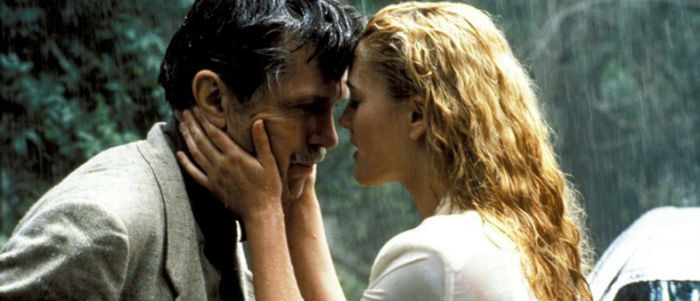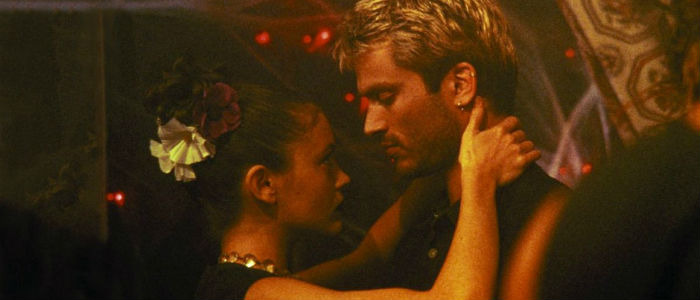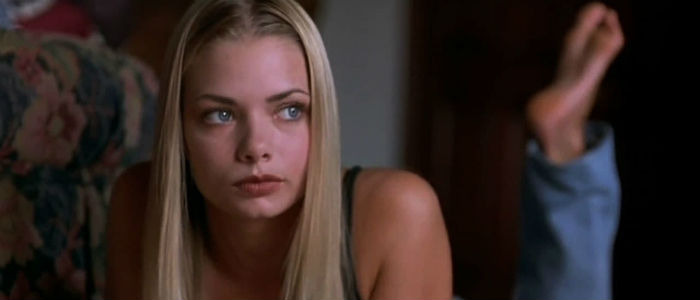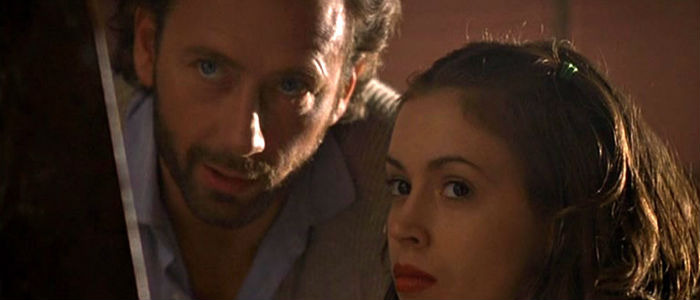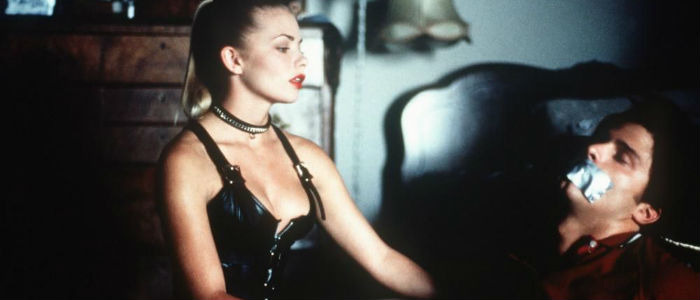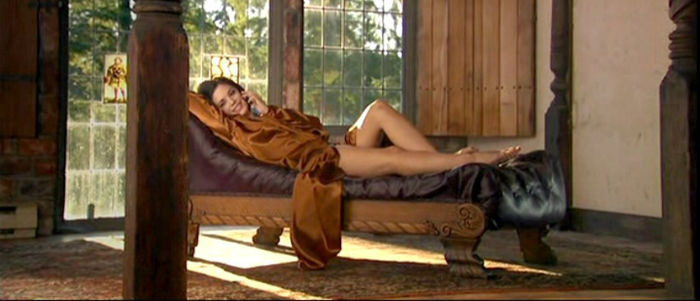Two Threads Run Through All Four 'Poison Ivy' Films, And One Isn't What You Think
(Welcome to DTV Descent, a series that explores the weird and wild world of direct-to-video sequels to theatrically released movies. In this edition, things get dirty with inappropriately seductive women, idiotically horndog men, and venomous plants in name only.)
I didn't intentionally make the title of this week's column sound like a math problem, but if it's any consolation the films we're looking at today require very little in the way of heavy thinking. This is purely fluff cinema designed for film fans drawn to naughty women, worse men, and flora taxonomy.
Poison Ivy didn't exactly set the world ablaze back in the early 90s — it cost $3 million and earned even less — but it found a home on VHS and pay cable meaning it remained in the public consciousness long after its theatrical run would have suggested it be forgotten. That awareness was enough of a reason to justify not one, not two, but three direct to DVD sequels of wildly varying quality. (The last film premiered on TV but was immediately followed by a DVD release featuring five minutes of extra footage in the form of T&A.) All four films, the entire quadrilogy if you will and I know you will, are now available in a box set from Scream Factory, so it seemed like the perfect time to dive right in and see what these sequels had to offer.
Turns out the answer is skin, morally bankrupt men, and a very specific manner of death.
The Beginning
Sylvie is a bit of an oddball teen made even shyer by a bed-ridden mother she's incapable of connecting with. When she spots Ivy at a popular hangout spot for mute teens it's with a recognition of both disdain and envy — here's someone who looks slutty but also appears carefree — and the two become fast friends to the point that Ivy essentially moves into Sylvie's house. It soon becomes clear, though, that Ivy is a master manipulator capable of seducing all three family members in different ways and with deadly results. She woos Sylvie, sleeps with her father, and pushes mom out a window. You might say Ivy is poisonous to this family's happiness and well-being. I'm not saying it, but you might.
The DTV Plot
Poison Ivy 2: Lily (1996) introduces Lily, a young woman who's new in town and lonely but who meets new people through her art class, shared apartment, and babysitting job. She's a shy virgin prone to daydreams scored by Enigma, but she begins to open up after discovering Ivy's diary — yes that Ivy but played by someone else in Lily's nude visions of her — detailing her own blossoming approach to self-image and seduction. Ivy's words have an effect on her, and soon she's cutting her hair, boning the lead singer of The Oneders, and unintentionally arousing her pervy teacher. She also catches the attention of her mute, eyebrow-less flatmate, and with three men eyeballing her derriere things are bound to get really sticky really fast.Poison Ivy: The New Seduction (1997) opens in the mid-1980s with 9-year-old Ivy and her younger sister Violet playing in a mansion where their mother works as a maid. Mom's having an affair with the man of the house and shtupping the pool boy on the side, but her naked shell game implodes on discovery sending her and her daughters back out into the world. Violet returns to the house 11 years later for revenge and follows in her dead sister's sexy footsteps by building a friendship, banging the older man, and intentionally causing discontent and trouble while wearing someone else's clothes (or no clothes at all).Poison Ivy: The Secret Society (2008) sends country girl Daisy to an exclusive private school in New England where she's quickly pegged by the dean's son and the members of a secret society that's so secret they live in a shared house, talk about themselves openly, and sport matching "ivy" tattoos above their ass-cracks. Their leader, Azalia — obviously — wants Daisy to join so she can be controlled and prevented from landing a coveted internship in D.C. that Azalia wants for herself. Daisy tries to walk the straight and narrow, but all bets are off after a video leaks of her riding her favorite teacher's son. (Don't worry, she's not stepping out on the dean's son as they're the same cool guy! There are only two administrators in this entire school and they're both this jerk's parents.)
Talent Shift
Poison Ivy's big get was Drew Barrymore (Freddy Got Fingered, 2001) in her "coming out" role as a bad girl leaving her childhood films behind. She plays it flashy and loud against the far more insular Sara Gilbert (High Fidelity, 2000), and the contrast is exactly as intended. The supporting cast is rounded out by the always great Tom Skerritt (Savage Harvest, 1981) as the pervy father and Cheryl Ladd (Millennium, 1989) as the mentally unstable mother, but we also get a three-second non-speaking role filled by Leonardo DiCaprio! The off-camera talents aren't quite as recognizable, but writer/director Katt Shea came to the project with a filmography filled with dance-related exploitation flicks including Stripped to Kill (1987), Stripped to Kill 2: Live Girls (1989), Dance of the Damned (1989), and Dance with Death (1992), and that has to count for something.Lily sought a similar lead — someone known more as a fresh-faced child actor — and found it in Alyssa Milano (Commando, 1985), but they still missed out on debuting her more grown-up attributes by a year as the saucy supernatural shocker Embrace of the Vampire was released in 1995. Johnathon Schaech (The Scare Hole, 2004) plays the hunky, moody artist whose paintbrush she can't stop gripping, and Xander Berkeley (Candyman, 1992) breathes sleazy life into the art teacher who finds inspiration in her form. The film is once again written and directed by women, Chloe King and Anne Goursaud respectively, and both put their experiences from working on Red Shoe Diaries (1992-1996) to good use here. King's script feels like it was repurposed to fit the franchise while Gousaud also directed Milano in Embrace of the Vampire where they clearly found a good report.The New Seduction lowers the bar quite a bit further and drops the attempts at stunt casting all together by giving newcomer Jaime Pressly (Not Another Teen Movie, 2001) her first lead role. She later went on to showcase real acting chops and some terrific comedic skills, but here she's little more than a frequently nude reboot of the original Ivy. Michael Des Barres (Ghoulies, 1984) takes naughty dad duties this time around, but the biggest on-screen highlight is genre vet Susan Tyrrell (Angel, 1984). Director Kurt Voss and writer Karen Kelly were working filmmakers for a while there.
And then there's The Secret Society. There are a couple recognizable faces you won't be able to put a name to leaving Catherine Hicks (Child's Play, 1988) and Greg Evigan (DeepStar Six, 1989) as the two biggest names here. It was also directed by a dude and features a screenplay credited to three writers who probably don't go around bragging about it.
How the Sequels Respect the Original
The sequels promote the difficult to argue with truth that far too many men are absolute bastards willing to cheat on their loved ones with uncomfortably young women. The women are the leads, sometimes innocent and sometimes malicious, but they attract some real winners tempted by the seemingly forbidden fruit of their looms. To that end, the sequels ramp up the T&A factor considerably from the first film's more suggestive approach — Maurice Ravel's Bolero kicks in every time Violet swims naked in The New Seduction — leaving the sequels only two truly consistent throughlines from the first film.
The first is the obvious — women named after vegetation are more trouble than they're worth. Ivy, Lily, Violet, Daisy, Azalia — if you see these girls coming you'll want to keep your stamen in your pants and run the other way guys. The second connective thread is far more low-key and probably entirely unintentional, but I find it interesting all the same. Someone falls to their death in all four movies. All four! Seems trivial perhaps, but there are only one or two deaths per film making this a highly suspicious way to go time after time. In the first film Sylvie's mom takes a dive and then it's Ivy herself after having committed murder, in the second it's the sketchy teacher after attempting to commit murder, in the third it's poor demented Violet after she commits murder, and in the fourth... well okay fine it's a minor character named Alexis who we're told fell to her death offscreen, but still, something to think about.
How the Sequels Shit on the Original
The first film is a sensual thriller about friendship, manipulation, and inviting the devil into your home, and while "sexy" things are transpiring they're hinted and teased more than explicitly shown. The closest we get to nudity is a very brief breast glimpse and a bare-assed Tom Skerritt. All three sequels leave suggestion behind and go full bore, though, with boobs, behinds, and lots and lots of thrusting. While Poison Ivy would play on HBO, these are the movies that would be playing on Skinemax. If you're in it for the T&A then the hump you're after is the middle of the franchise as parts 2 and 3 are most interested in delivering those particularly sexy and salacious shenanigans. Part 4 is strictly amateur hour in that department with generic sex scenes, low-grade cinematography, obvious soundstages, and more fake breasts than most college campuses can claim. This probably won't surprise you, but the two films that seem most interested in objectifying naked women are the two directed by men. It gets so bad in the last film that while the women are naked the guys don't even strip down for sex — the dean's son does it with his underwear still on.
Two of the sequels forego the plot structure of the first to varied effect. Lily flips the script with its lead being a good girl who discovers a taste for the sex stuff, but it drops the thriller route taken by its predecessor almost completely (until the final ten minutes anyway) choosing instead to take a page from The World According to Garp in its approach to the high cost of infidelity. (Car meet child...) It's every bit an extended episode of Red Shoes Diaries rather than a true suspense movie.
The New Seduction is a return to form, but then The Secret Society comes along and just settles for a poor man's The Skulls (2000) instead. The lead is again the good girl leaving Azalia the one to act unnecessarily homicidal in her pursuit of [checks notes] an internship. The relative simplicity of the earlier films turns convoluted and ridiculous here with sadly tangential attempts at connecting this to the Poison Ivy shared universe. See, the secret society is called the Ivys...
Conclusion
1992's Poison Ivy is no great shakes, but it works the same way films like The Hand that Rocks the Cradle (1992) and Unlawful Entry (1992) do as warnings about not bringing strangers into your safe suburban domiciles where they just might have sex with your significant other. (All three in the same year... what the hell was going on in the early 90s to stir up this fear?) The sequels are no closer to being classics, but the only one truly worth avoiding is the last as it's wholly irredeemable. Lily and The New Seduction both have their charms, though, with the latter offering some sexy and sad closure to the saga of Ivy's messed up bloodline, and if nothing else you'll get to see a lot of people fall to their death.

